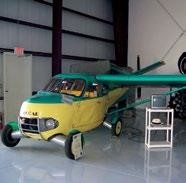Mankind looks to the skies.


Mankind looks to the skies.
Uber taxi.
Advances in drone technology and materials science mean that flying cars are now in the picture again. Today, there are over a dozen companies trying to build flying cars. But did you know one of the earliest flying cars actually took the skies way back in 1949?
It was called the Aerocar and it was literally a car that could convert into a plane. When the Aerocar arrived at an airfield, its wings and tail could be attached along with the propeller shaft and pusher propeller, thereby transforming it into a plane. The process takes quite a while and because of the costs and the sheer number of licenses required to operate it, the Aerocar never quite took off. In the end, only six examples were ever built.

Taylor Aerocar.
Flying cars today are much more sophisticated and the most advanced of them is arguably the Terrafugia Transition. On the road, it can travel up to 110km/h - so it will have no problem blending with highway traffic - and it is small enough to fit into most household garages. When it is time to fly, its wings and tail unfold in less than a minute - which is considerably quicker than the Aerocar. With the wings unfolded, the Transition can take its pilot and one passenger on a 644km trip at an altitude of up to 9,000 feet - enough to get you from Singapore to Kuala Lumpur and back. But most incredible of all is that Terrafugia claims that the Transition will go sale sometime this year (2019).

Terrafugia Transition.
There is also another type of flying car that can be more accurately described as a personal air vehicle. These types of flying cars can’t be driven on the road, are often autonomous, and are designed to fly small group of passengers over short to medium distances. An example is the Kitty Hawk Cora. A fully autonomous electric personal aircraft that is powered by eight battery-powered propellers and has a range of 100km and a speed of 150km/h. Apart from Kitty Hawk, a handful of other companies such as Uber, Airbus, Rolls Royce, Opener, and more are working on such flying cars in the hopes of alleviating traffic jams and advancing mobility for mankind.
THE PROBLEMS WITH FLYING
It is clear that the technology to enable flying vehicles is already here, but the reason why we’re not all zipping through the skies yet is because of infrastructure and legislation – the biggest challenges to realizing flying cars right now. Where can we take off and land? How do we build highways in the air, or control and enforce air traffic? How will governments patrol borders? What about accident and casualty mitigation, not just for the passengers of flying cars, but those on the ground in event of a crash? These are only the tip of the iceberg of issues that need to be address before we can see flying cars becoming a mainstream reality.























